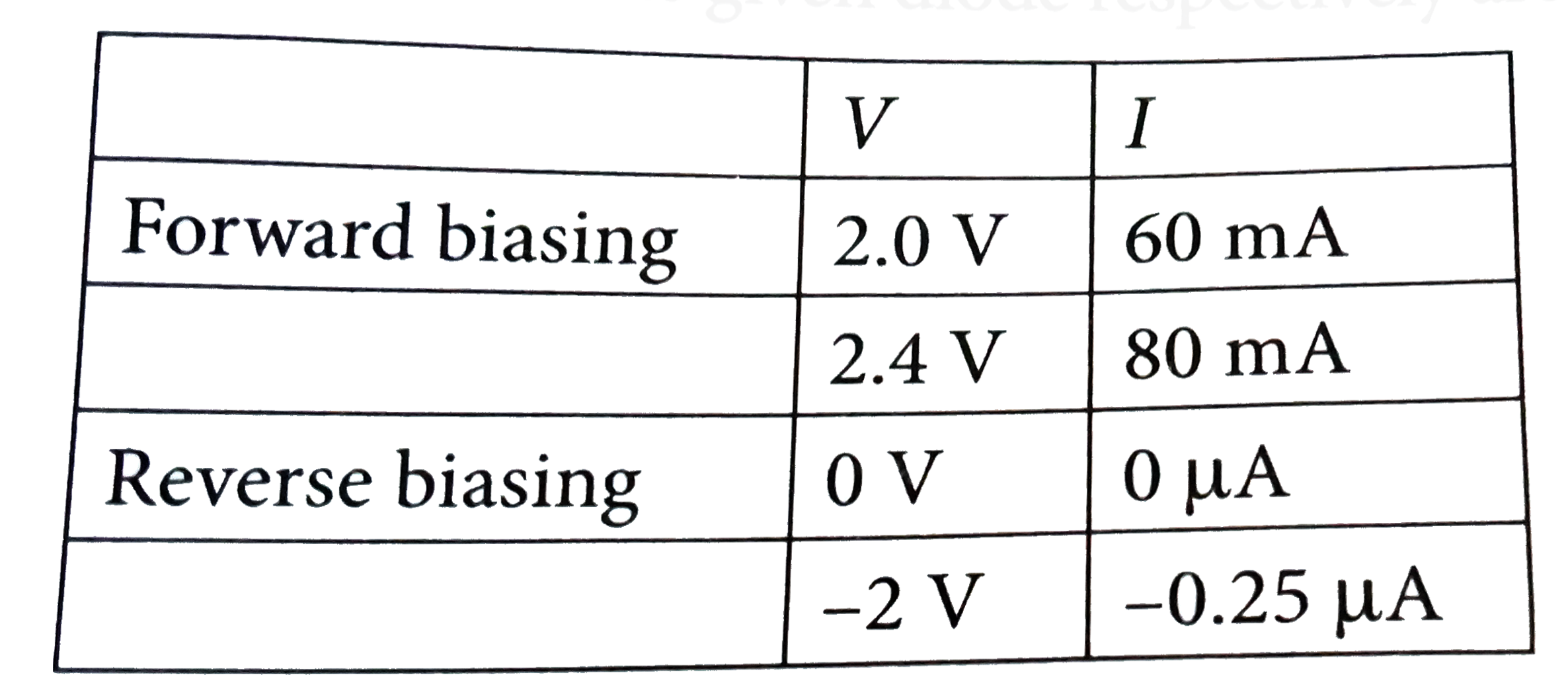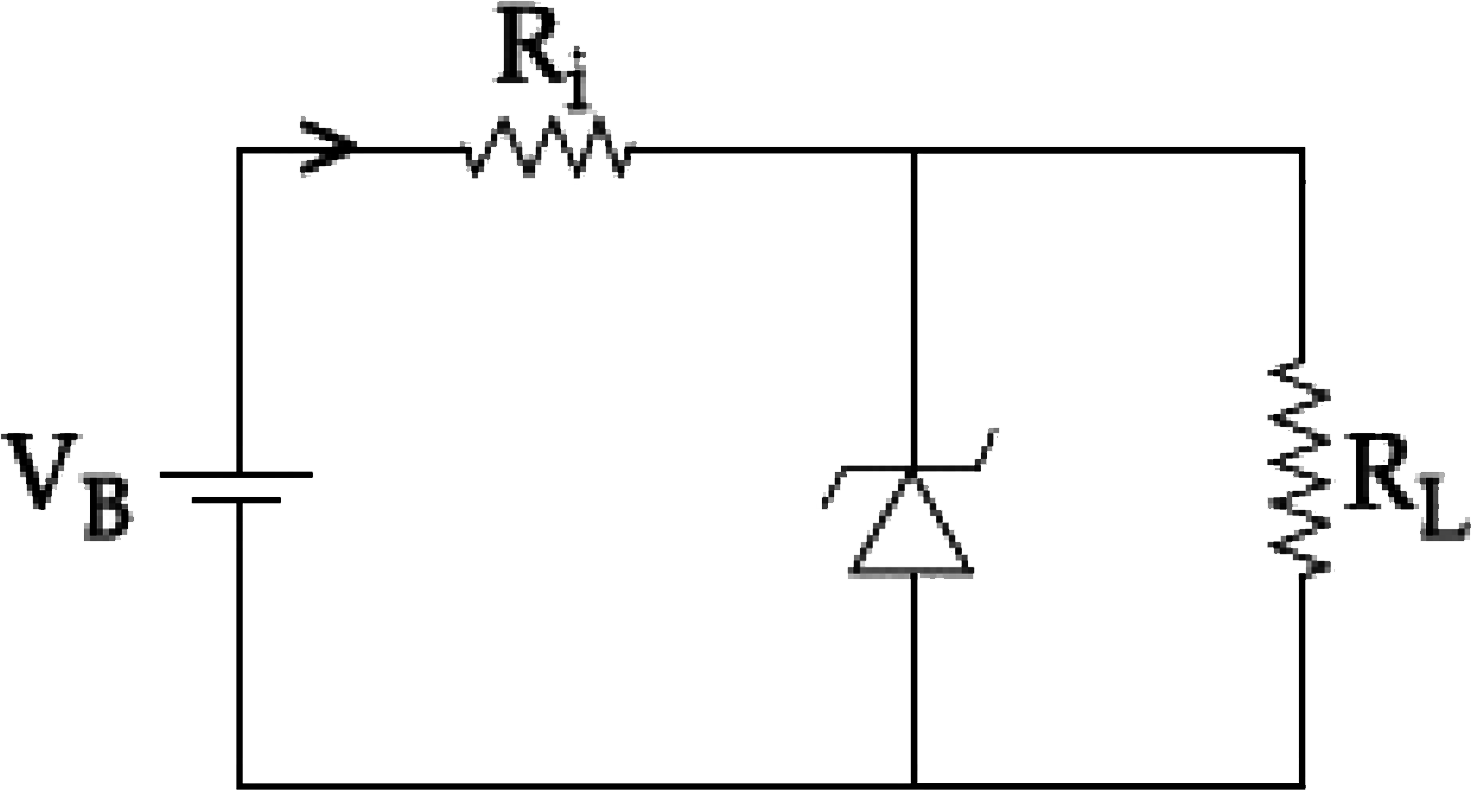In a reverse biased diode, when the applied voltage changes by 1V, the current is found to change by 0.5μA. The reversebiase resistance of the diode is
2×105Ω
2×106Ω
200Ω
2Ω
The correct Answer is:B
To find the reverse bias resistance of the diode, we can use Ohm's law, which states that:
V=I⋅R
Where:
- V is the voltage across the diode,
- I is the current flowing through the diode,
- R is the resistance.
1. Identify the Change in Voltage and Current:
- The change in voltage (ΔV) is given as 1V.
- The change in current (ΔI) is given as 0.5μA=0.5×10−6A.
2. Use Ohm's Law to Find Resistance:
- Rearranging Ohm's law to solve for resistance gives us:
R=VI
- In this case, we will use the changes in voltage and current:
R=ΔVΔI
3. Substitute the Values:
- Substitute ΔV=1V and ΔI=0.5×10−6A:
R=1V0.5×10−6A
4. Calculate the Resistance:
- Performing the calculation:
R=10.5×10−6=10.5×106=2×106Ω
5. Conclusion:
- The reverse bias resistance of the diode is 2×106Ω.
Final Answer:
The reverse bias resistance of the diode is 2×106Ω.
---
- V is the voltage across the diode,
- I is the current flowing through the diode,
- R is the resistance.
- The change in voltage (ΔV) is given as 1V.
- The change in current (ΔI) is given as 0.5μA=0.5×10−6A.
- Rearranging Ohm's law to solve for resistance gives us:
R=VI
- In this case, we will use the changes in voltage and current:
R=ΔVΔI
- Substitute ΔV=1V and ΔI=0.5×10−6A:
R=1V0.5×10−6A
- Performing the calculation:
R=10.5×10−6=10.5×106=2×106Ω
- The reverse bias resistance of the diode is 2×106Ω.
The reverse bias resistance of the diode is 2×106Ω.
Topper's Solved these Questions
- BOOK - AAKASH INSTITUTE ENGLISHCHAPTER - SEMICONDUCTOR ELECTRONICS (MATERIAL, DEVICES AND SIMPLE CIRUITS )EXERCISE - EXERCISE20videos
SEMICONDUCTOR ELECTRONICS (MATERIAL, DEVICES AND SIMPLE CIRUITS )
- BOOK - AAKASH INSTITUTE ENGLISHCHAPTER - SEMICONDUCTOR ELECTRONICS (MATERIAL, DEVICES AND SIMPLE CIRUITS )EXERCISE - Assignment section -A (Objective Type Question)43videos
SEMICONDUCTOR ELECTRONICS (MATERIAL, DEVICES AND SIMPLE CIRUITS )
- BOOK - AAKASH INSTITUTE ENGLISHCHAPTER - SEMICONDUCTOR ELECTRONICS (MATERIAL, DEVICES AND SIMPLE CIRUITS )EXERCISE - Assignment SECTION - D (Assertion & reason type Question)10videos
SEMICONDUCTOR ELECTRONICS (MATERIAL, DEVICES AND SIMPLE CIRUITS )
- BOOK - AAKASH INSTITUTE ENGLISHCHAPTER - RAY OPTICS AND OPTICAL INSTRUMENTSEXERCISE - ASSIGNMENT (SECTION - D)16videos
RAY OPTICS AND OPTICAL INSTRUMENTS
- BOOK - AAKASH INSTITUTE ENGLISHCHAPTER - SEMICONDUCTOR ELECTRONICS: MATERIALS, DEVICES AND SIMPLE CIRCUITSEXERCISE - Assignment (Section-D (Assertion and reason))5videos
SEMICONDUCTOR ELECTRONICS: MATERIALS, DEVICES AND SIMPLE CIRCUITS
Similar Questions
Knowledge Check
- Question 1 - Select One
The following table provides the set of values of V and I obtained for a given diode. Let the characteristics α be nearly linear, over this range, the forward and reverse bias resistance of the given diode respectively are
 A10Ω,8×106ΩB20Ω,4×105ΩC20Ω,8×106ΩD10Ω,10Ω
A10Ω,8×106ΩB20Ω,4×105ΩC20Ω,8×106ΩD10Ω,10Ω
If the forward voltage in a semiconductor diode is chaged form 0.5 V to 2 V, then the forward current changed by 1.5 mA. The forward resistance of diode will be-
View SolutionA transistor is used in Common-emitter mode in an amplifier circuits. When a signal of 20 mV is added to the base-emitter voltage, the base current changes by 40μA and the collector current changes by 2mA. The load resistance is 5kΩ then the voltage gain is
View SolutionWhen the reverse potential in a semiconductor diode are 10 V and 30 V, thent he corresponding reverse currents are 25μA. And 50μA respectively. The reverse resistance of junction diode will be-
View Solution
the figure represents a voltage regulator circuit using a zener diode. The breakdown voltage of the zener diode is 6 V and the load resistance is RL=4kΩ the series resistance of the circuit is Ri=1kOMega. if the battery voltage VB varies from 8 V to 16 V, what are the minimum and maximum values of the currect through Zener diode?View SolutionWhen the forwward bias voltage of a diode is changed from 0.6 V to 0.7 V the current changes from 5 mA to 15 mA. Then its forward bias resistance is
View SolutionIn a P-N junction , for a 0.2 V change in the forward bias voltage, the corresponding change in current is 20 mA. The dynamic resistance of the P-N junction is
View SolutionIn a fluorscent lamp choke (a small transformer) 100V of reverse voltage is produced when the choke current changes uniformly from 0.25 A to 0 in a duration of 0.025 ms. The self-inductance of the choke (in mH) is estimated to be……………..
View Solution

